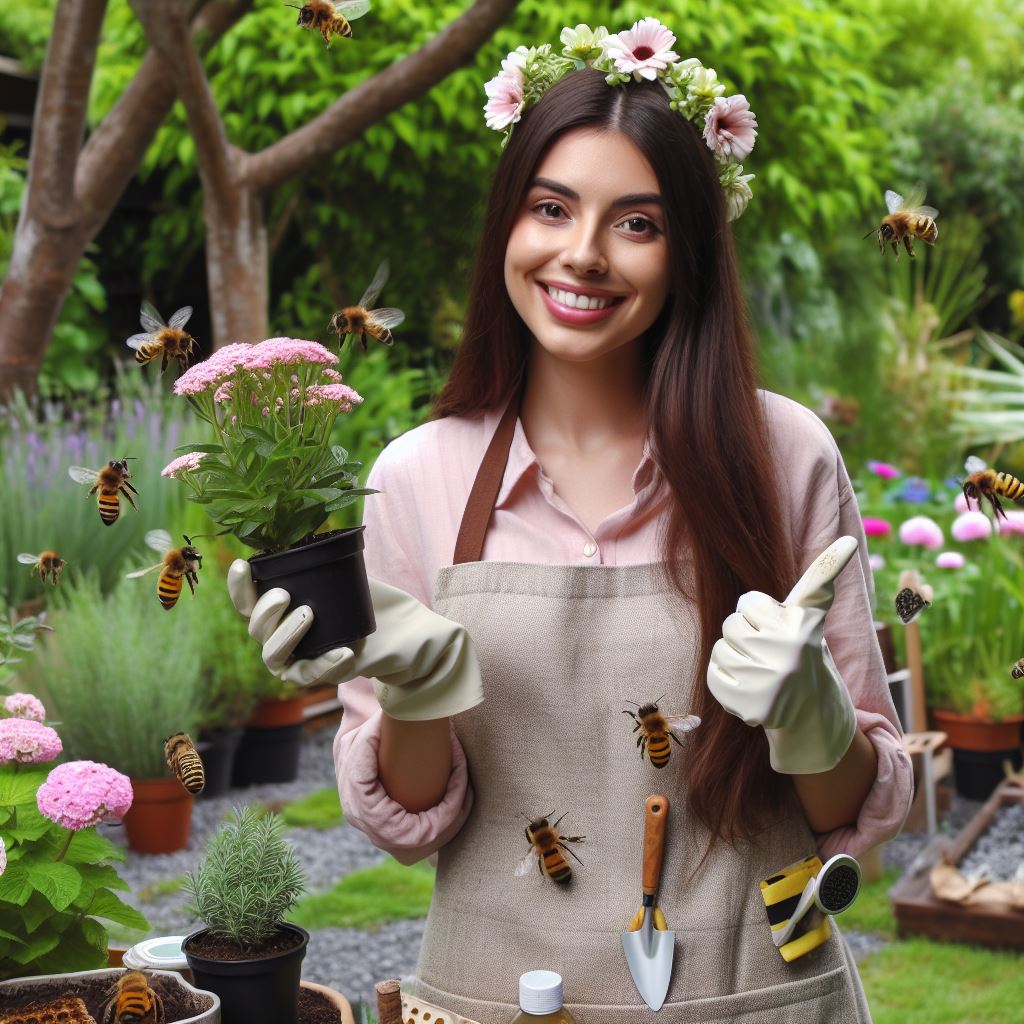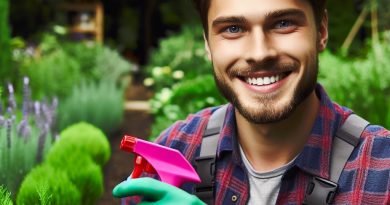Bee-Friendly Gardening: Tips & Plants
Last Updated on February 9, 2024
Introduction
Importance of bee-friendly gardening
Let’s Explore Bee-Friendly Gardening: Tips & Plants
Bees are indispensable pollinators, essential for the reproduction of many plants and the production of fruits and seeds.
Supporting bee populations is crucial for maintaining biodiversity and ecosystem health.
- Bees play a vital role in pollination: They transfer pollen between flowers, facilitating the fertilization process and enabling plants to reproduce.
- Bee-friendly gardens support bee populations: By providing a diverse array of nectar and pollen-rich flowers, gardens become vital forage areas for bees.
- They promote biodiversity and ecosystem health: Bee-friendly gardening practices contribute to the preservation of native plant species and the overall balance of natural ecosystems.
Purpose of the blog post
This blog aims to empower gardeners to create bee-friendly habitats by offering practical tips and highlighting top plants to attract bees.
By fostering awareness and action, we can collectively contribute to environmental stewardship and conservation efforts, ensuring the continued well-being of bees and the ecosystems they support.
Understanding Bee-Friendly Gardening
Definition and Concept of Bee-Friendly Gardening
Bee-friendly gardening refers to the practice of creating habitats and planting flowers that attract and nurture bees.
It involves using native plants, avoiding pesticides, and providing water sources.
This type of gardening aims to support and protect the declining bee populations.
To achieve a bee-friendly garden, it is essential to understand the concept and principles behind it.
By following these guidelines, you can create a thriving environment for bees while enjoying a beautiful and vibrant garden.
Benefits of Having a Bee-Friendly Garden
Pollination
Bees play a crucial role in pollination, enabling plants to reproduce.
By attracting bees to your garden, you will enhance pollination and ensure the growth and abundance of fruits, vegetables, and flowers.
Biodiversity
Creating a bee-friendly garden promotes biodiversity.
Bees are vital pollinators for a wide variety of plants, including many native species.
By providing a welcoming habitat, you help maintain a diverse plant population, which is essential for a healthy ecosystem.
Plant Health
Bees are excellent indicators of a healthy environment.
When bees thrive, it is a sign that the garden ecosystem is well-balanced and free from harmful chemicals.
A bee-friendly garden encourages natural pest control and reduces the need for pesticides, thus promoting the overall health of your plants.
Beautification
Planting flowers that attract bees adds beauty and color to your garden.
You can choose from various bee-friendly plant species, such as lavender, sunflowers, coneflowers, and wildflowers.
Not only will these plants attract bees, but they will also create a visually stunning display in your outdoor space.
Educational Opportunities
A bee-friendly garden provides an excellent opportunity to educate yourself and others about the importance of bees and their role in our ecosystem.
By observing bees’ behavior and learning about their preferences, you can gain a deeper understanding of the natural world around you.
Creating a bee-friendly garden is relatively simple. Start by selecting native plant species that are known to attract bees.
These plants have developed a natural relationship with local pollinators, making them highly effective in supporting bee populations.
Avoid using pesticides in your garden, as they are harmful to bees and can disrupt their natural behaviors.
Instead, practice organic pest control methods, such as companion planting and beneficial insect release.
This will ensure that your garden remains safe for bees and other beneficial insects.
Provide a water source for bees by incorporating shallow dishes or bird baths into your garden.
Bees need access to clean water to drink and cool down.
Adding rocks or pebbles to these water sources will also help bees safely land and access the water.
Creating shelter for bees is another essential aspect of bee-friendly gardening.
Consider installing bee hotels or leaving undisturbed areas in your garden where bees can build nests and hibernate during winter.
Therefore, understanding bee-friendly gardening and its benefits is crucial for creating a thriving garden ecosystem.
By following these principles and adopting bee-friendly practices, you can play a part in preserving bee populations and enjoying the many rewards of a buzzing and beautiful garden.
Read: Plant Diseases: Identification & Control

Tips for creating a bee-friendly garden
Avoiding harmful chemicals and pesticides
- Use organic alternatives for pest control: Instead of relying on synthetic pesticides, opt for natural and organic options. These products are less toxic to bees and other beneficial insects, safeguarding their health and population.
- Natural methods to deter pests: Implement strategies such as companion planting, where certain plants repel pests, or physical barriers like nets and row covers to keep insects away. By using these methods, you can effectively control pests without harming bees or other pollinators.
Planting native flowers and plants
- Researching local native plants: Before starting your garden, take the time to research native plants in your area. These plants have coevolved with local bees, providing them with a rich source of pollen and nectar. By planting native species, you support the natural ecosystem and help sustain local bee populations.
- Choosing plants with diverse bloom times: Bees need a continuous supply of nectar and pollen throughout the year. By selecting plants that bloom at different times, you create a steady food source for bees. Aim for a variety of flowers that bloom in spring, summer, and fall to cover the bees’ needs across different seasons.
Providing fresh water sources for bees
- Creating shallow water dishes or birdbaths: Bees require access to water for hydration. Set up shallow water dishes with stones or floating objects where bees can land and drink safely. Birdbaths with shallow areas also serve as excellent water sources for bees.
- Ensuring clean and accessible water: Regularly clean and refill the water sources to prevent the growth of algae or mosquito larvae. Bees need clean water without any obstacles like slippery surfaces or deep water that may hinder their access. Maintain a reliable and accessible water supply to support the bee population in your garden.
By following these tips, you can establish a bee-friendly garden that supports pollinators and promotes biodiversity.
Remember, small changes in gardening practices can make significant contributions to the well-being of bees and their crucial role in our ecosystem.
Read: Gardening in Drought Conditions
Top bee-friendly plants for a garden
Flowers rich in nectar and pollen
- Sunflowers: Sunflowers are not only a stunning addition to any garden but also a favorite among bees. Their large, vibrant blooms offer abundant nectar and pollen, attracting bees and other pollinators throughout the growing season. Plant sunflowers in a sunny spot with well-draining soil for optimal growth and bee activity.
- Lavender: Lavender’s fragrant purple spikes not only add beauty and aroma to the garden but also serve as a magnet for bees. Bees are attracted to lavender’s sweet scent and rich nectar, making it a must-have plant for any bee-friendly garden. Plant lavender in well-drained soil and provide ample sunlight to encourage vigorous growth and bee activity.
- Coneflowers: Coneflowers, also known as echinaceas, are beloved by bees for their daisy-like blooms and abundant nectar. These hardy perennials provide bees with a rich source of pollen and nectar, making them a valuable addition to any bee-friendly garden. Plant coneflowers in a sunny location with well-drained soil to ensure healthy growth and prolific blooming.
Herbs that attract bees
- Rosemary: Rosemary is not only a versatile culinary herb but also a favorite among bees. Its aromatic foliage and delicate flowers attract bees and other pollinators, ensuring a steady supply of nectar throughout the growing season. Plant rosemary in well-drained soil and provide plenty of sunlight to encourage robust growth and bee activity.
- Sage: Sage, with its aromatic leaves and vibrant flowers, is a popular choice for bee-friendly gardens. Bees are drawn to sage’s sweet-smelling blooms, making it an essential plant for supporting pollinator populations. Plant sage in a sunny spot with well-drained soil and watch as bees flock to its fragrant flowers.
- Thyme: Thyme’s tiny flowers may be small, but they pack a big punch when it comes to attracting bees. Bees are drawn to thyme’s delicate blooms, which offer a rich source of nectar and pollen. Plant thyme in well-drained soil and provide plenty of sunlight to encourage healthy growth and bee activity.
Shrubs and trees preferred by bees
- Blueberries: Blueberry bushes not only produce delicious berries but also offer abundant flowers that attract bees. Bees are essential for pollinating blueberry flowers, ensuring a bountiful harvest. Plant blueberries in acidic, well-drained soil and provide adequate water to support healthy growth and fruit production.
- Apple trees: Apple trees burst into bloom in spring, covering themselves in a profusion of sweet-smelling flowers that attract bees. Bees play a vital role in pollinating apple blossoms, leading to the formation of fruit. Plant apple trees in a sunny location with well-drained soil and provide adequate space for them to mature and produce fruit.
- Elderberries: Elderberry shrubs produce clusters of creamy-white flowers that are highly attractive to bees. Bees visit elderberry flowers to collect nectar and pollen, aiding in pollination and fruit set. Plant elderberries in moist, well-drained soil and provide plenty of sunlight to encourage healthy growth and abundant flowering.
By incorporating these top bee-friendly plants into your garden, you can create a haven for bees and other pollinators while enhancing the beauty and productivity of your outdoor space.
Read: Balcony Farming: Urban Agriculture Tips
Maintenance and Care for a Bee-Friendly Garden
A vibrant and thriving bee-friendly garden requires regular maintenance and care to ensure the well-being of the pollinators.
By following these tips, you can create an environment that will support and attract bees throughout the year.
Regular Watering and Fertilizing Tips
- Water your garden regularly to keep the soil moist, especially during dry spells, as bees need water for hydration.
- Use a drip irrigation system or a soaker hose to provide a slow, steady supply of water, reducing evaporation and runoff.
- Avoid using chemical fertilizers that can be harmful to bees. Instead, opt for organic fertilizers or compost to nourish your plants naturally.
- Apply fertilizers sparingly and according to package instructions to prevent overfeeding your plants, which can lead to excessive foliage growth and reduced flower production.
Pruning and Deadheading Flowers
- Regularly prune and deadhead your flowers to promote continuous blooming and maintain the overall health of your plants.
- Remove faded or spent flowers to prevent them from going to seed and redirect the plant’s energy towards producing new blooms.
- Prune any damaged or diseased branches to prevent the spread of infections and improve air circulation within the garden.
- Use clean pruning tools to avoid transferring diseases between plants, especially when dealing with susceptible species.
Providing Shelter with Bee Houses or Nesting Materials
- Install bee houses or nesting materials to provide shelter for solitary bees, such as mason bees and leafcutter bees.
- Position bee houses in a sunny area, protected from strong winds and rain, and mount them securely on a wall or fence.
- Use natural nesting materials like bamboo tubes, drilled wooden blocks, or hollow plant stems to create nesting opportunities for bees.
- Clean and maintain bee houses annually by removing any debris or pests to prevent the spread of diseases.
By maintaining a healthy and well-cared-for garden, you not only create a beautiful sanctuary for bees but also reap the rewards of increased pollination and bountiful harvests.
Remember, bees are highly efficient pollinators, and their presence is vital for the health and survival of our ecosystems.
Read: Soil Health: Key to Thriving Gardens
Conclusion
The importance of bee-friendly gardening cannot be overstated.
Bees are vital pollinators that help to sustain our ecosystems and food supply.
Creating a bee-friendly garden is not only beneficial for the environment but also brings beauty and vibrancy to your space.
By incorporating bee-friendly plants into your garden, you are providing ample nectar and pollen sources for bees to nourish themselves and their colonies.
These plants include lavender, sunflowers, wildflowers, and herbs such as thyme, rosemary, and mint.
Additionally, avoiding the use of harmful pesticides and opting for organic gardening practices will further promote the well-being of bees.
With their population declining due to habitat loss and pesticide exposure, it is crucial for individuals to take action and create bee-friendly spaces.
Not only will you be helping to ensure the survival of these important pollinators, but you will also be creating a haven for other beneficial insects and wildlife.
Imagine the joy of watching bees buzzing from flower to flower, the soothing sound of their gentle hum, and the satisfaction of knowing you are making a difference.
Bee-friendly gardening is not only a responsible and rewarding choice, but it also contributes to the health of our planet.
So, why not embrace this opportunity to create a bee-friendly garden and be part of the solution?
Remember, every small effort counts, and together, we can make a significant impact in preserving these essential creatures for generations to come.


